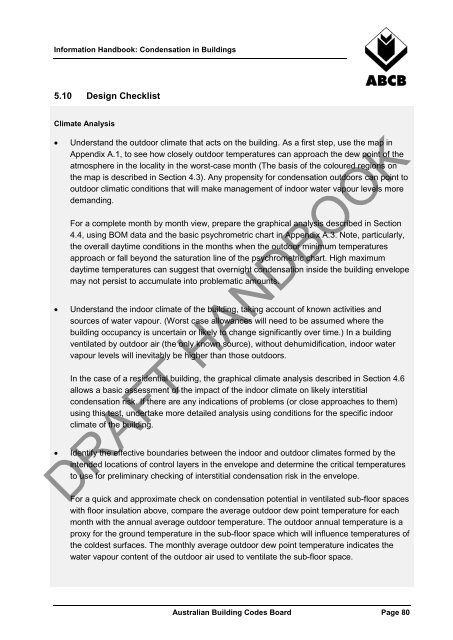Condensation in Buildings - Australian Building Codes Board
Condensation in Buildings - Australian Building Codes Board
Condensation in Buildings - Australian Building Codes Board
You also want an ePaper? Increase the reach of your titles
YUMPU automatically turns print PDFs into web optimized ePapers that Google loves.
Information Handbook: <strong>Condensation</strong> <strong>in</strong> Build<strong>in</strong>gs<br />
5.10 Design Checklist<br />
Climate Analysis<br />
• Understand the outdoor climate that acts on the build<strong>in</strong>g. As a first step, use the map <strong>in</strong><br />
Appendix A.1, to see how closely outdoor temperatures can approach the dew po<strong>in</strong>t of the<br />
atmosphere <strong>in</strong> the locality <strong>in</strong> the worst-case month (The basis of the coloured regions on<br />
the map is described <strong>in</strong> Section 4.3). Any propensity for condensation outdoors can po<strong>in</strong>t to<br />
outdoor climatic conditions that will make management of <strong>in</strong>door water vapour levels more<br />
demand<strong>in</strong>g.<br />
For a complete month by month view, prepare the graphical analysis described <strong>in</strong> Section<br />
4.4, us<strong>in</strong>g BOM data and the basic psychrometric chart <strong>in</strong> Appendix A.3. Note, particularly,<br />
the overall daytime conditions <strong>in</strong> the months when the outdoor m<strong>in</strong>imum temperatures<br />
approach or fall beyond the saturation l<strong>in</strong>e of the psychrometric chart. High maximum<br />
daytime temperatures can suggest that overnight condensation <strong>in</strong>side the build<strong>in</strong>g envelope<br />
may not persist to accumulate <strong>in</strong>to problematic amounts.<br />
• Understand the <strong>in</strong>door climate of the build<strong>in</strong>g, tak<strong>in</strong>g account of known activities and<br />
sources of water vapour. (Worst case allowances will need to be assumed where the<br />
build<strong>in</strong>g occupancy is uncerta<strong>in</strong> or likely to change significantly over time.) In a build<strong>in</strong>g<br />
ventilated by outdoor air (the only known source), without dehumidification, <strong>in</strong>door water<br />
vapour levels will <strong>in</strong>evitably be higher than those outdoors.<br />
In the case of a residential build<strong>in</strong>g, the graphical climate analysis described <strong>in</strong> Section 4.6<br />
allows a basic assessment of the impact of the <strong>in</strong>door climate on likely <strong>in</strong>terstitial<br />
condensation risk. If there are any <strong>in</strong>dications of problems (or close approaches to them)<br />
us<strong>in</strong>g this test, undertake more detailed analysis us<strong>in</strong>g conditions for the specific <strong>in</strong>door<br />
climate of the build<strong>in</strong>g.<br />
• Identify the effective boundaries between the <strong>in</strong>door and outdoor climates formed by the<br />
<strong>in</strong>tended locations of control layers <strong>in</strong> the envelope and determ<strong>in</strong>e the critical temperatures<br />
to use for prelim<strong>in</strong>ary check<strong>in</strong>g of <strong>in</strong>terstitial condensation risk <strong>in</strong> the envelope.<br />
DRAFT HANDBOOK<br />
For a quick and approximate check on condensation potential <strong>in</strong> ventilated sub-floor spaces<br />
with floor <strong>in</strong>sulation above, compare the average outdoor dew po<strong>in</strong>t temperature for each<br />
month with the annual average outdoor temperature. The outdoor annual temperature is a<br />
proxy for the ground temperature <strong>in</strong> the sub-floor space which will <strong>in</strong>fluence temperatures of<br />
the coldest surfaces. The monthly average outdoor dew po<strong>in</strong>t temperature <strong>in</strong>dicates the<br />
water vapour content of the outdoor air used to ventilate the sub-floor space.<br />
<strong>Australian</strong> Build<strong>in</strong>g <strong>Codes</strong> <strong>Board</strong> Page 80
















